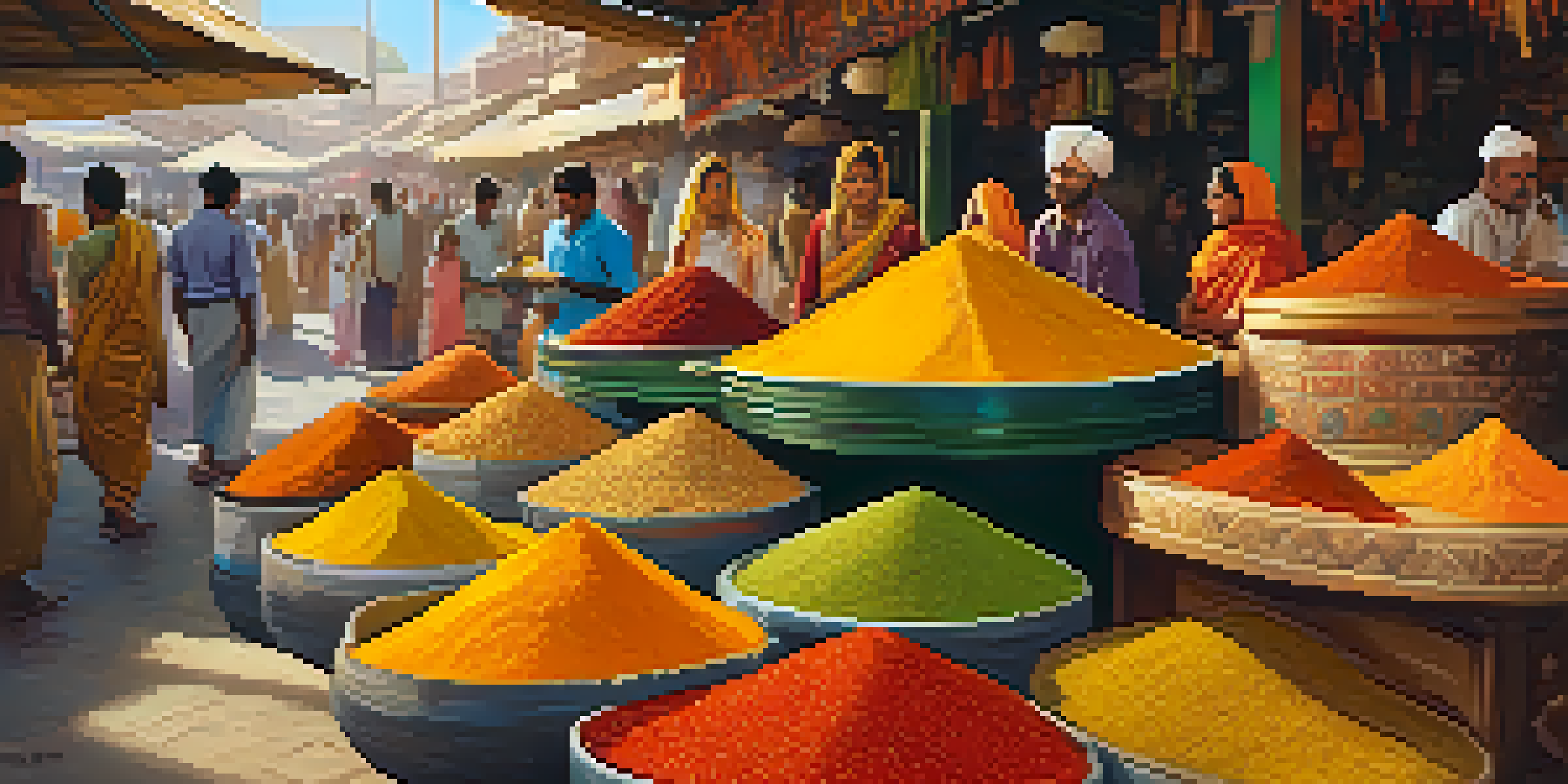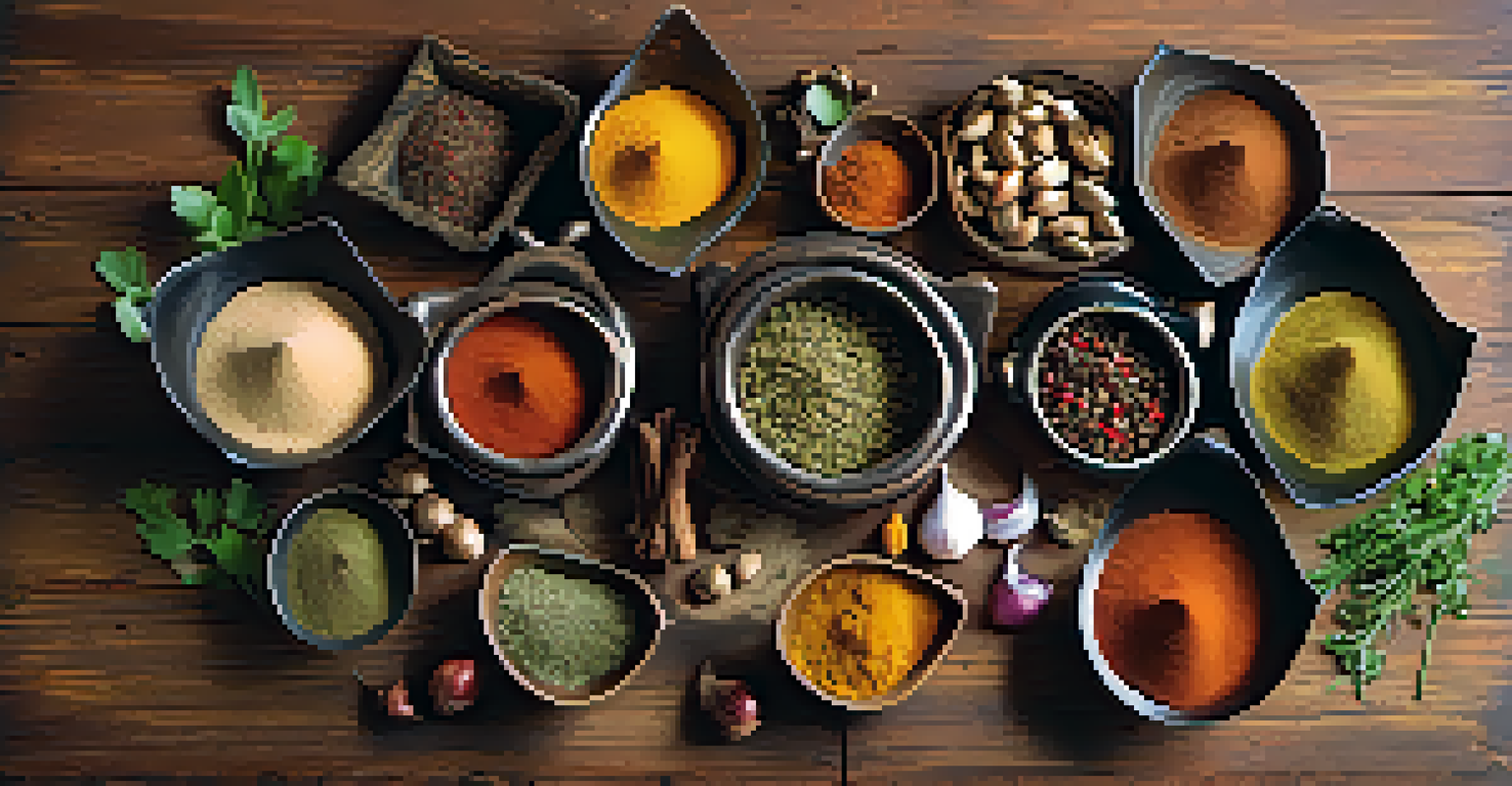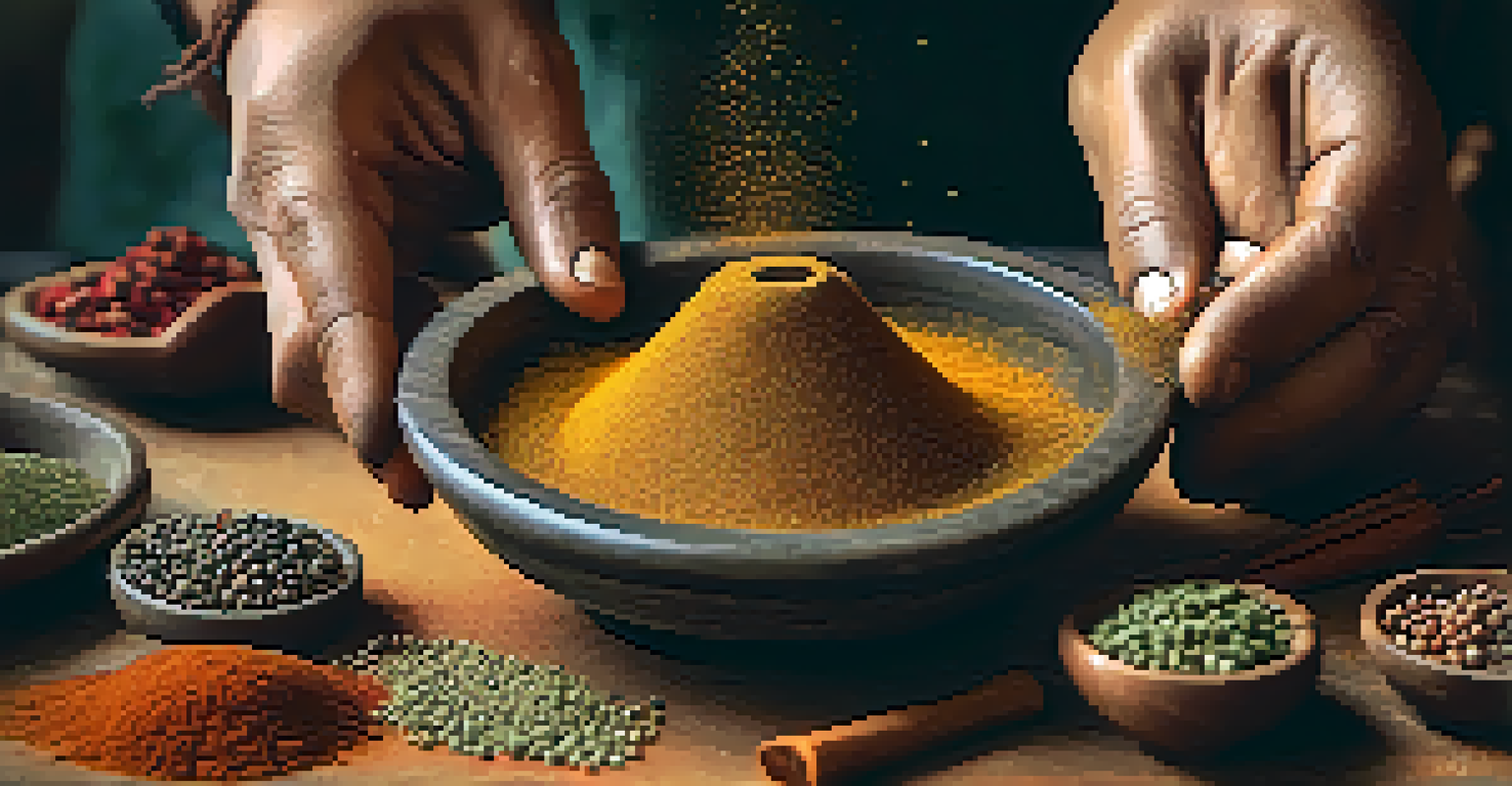The Historical Significance of Indian Spice Blends in Cuisine

Understanding the Role of Spices in Indian Cuisine
Spices are the heartbeat of Indian cuisine, adding depth, flavor, and aroma. They are not just ingredients; they are a way of life. From turmeric's vibrant yellow to the heat of chili, each spice brings its own character, enhancing dishes in unique ways.
Spices are the guardians of flavor, the keepers of tradition, and the catalysts of creativity in every kitchen.
These spices have been used for centuries, often rooted in tradition and passed down through generations. They play a critical role in health and wellness, with many believed to have medicinal properties. This connection between food and health showcases the cultural significance of spices in Indian society.
Moreover, spices are integral to regional identities in India. Each region boasts its own blend of spices, reflecting local agriculture and culinary practices. This diversity makes Indian cuisine a rich tapestry of flavors and traditions, inviting exploration and appreciation.
The Evolution of Spice Blends in India
The origins of spice blends in India can be traced back thousands of years, influenced by trade routes and cultural exchanges. The Silk Road, for instance, facilitated the movement of spices, introducing Indian blends to global palates. This interaction helped shape the distinctive flavors we recognize today.

Traditional blends like garam masala and curry powder have evolved, often incorporating spices from various regions. Each family or cook may have their own secret recipe, tailored to personal tastes and regional availability. This adaptability demonstrates the dynamic nature of Indian cuisine.
Spices Define Indian Culinary Identity
Spices are not just ingredients but essential elements that reflect regional identities and cultural practices in Indian cuisine.
As India embraced colonial influences, new spices and preparation methods blended into traditional practices. The result is a vibrant fusion that not only respects the past but also embraces innovation. Today, Indian spice blends continue to evolve, reflecting contemporary tastes while honoring their historical roots.
Cultural Significance of Spice Blends in Festivals
Spices hold a special place in Indian festivals, symbolizing prosperity, health, and joy. During celebrations like Diwali and Holi, traditional dishes prepared with specific spice blends are essential. They not only please the palate but also bring families together in the kitchen.
The world is but a canvas to the imagination; spices are the colors that bring our culinary art to life.
For instance, the fragrant biryanis made during weddings often include a blend of spices like cardamom and bay leaves, believed to enhance the auspiciousness of the occasion. Such practices highlight the integral role of spices in cultural rituals and community bonding.
Furthermore, these festive dishes often tell stories of heritage and family traditions. Each spice blend carries memories of gatherings and celebrations, making them more than just culinary components. They serve as vessels of culture, connecting generations through shared experiences.
The Global Impact of Indian Spice Blends
Indian spice blends have transcended borders, influencing global cuisine in remarkable ways. As Indian diaspora communities spread worldwide, they brought their culinary traditions with them, inspiring local adaptations. The popularity of curries and masalas in Western kitchens is a testament to this cultural exchange.
Restaurants featuring Indian cuisine have emerged globally, showcasing the versatility of spice blends. Chefs creatively incorporate these flavors into fusion dishes, making Indian spices accessible to a wider audience. This blend of tradition and innovation enriches the culinary landscape.
Cultural Significance in Celebrations
Spices play a vital role in Indian festivals, symbolizing prosperity and bringing families together through traditional dishes.
Moreover, the growing interest in health and wellness has spotlighted the benefits of spices like turmeric and cumin. Their anti-inflammatory and antioxidant properties have made them sought-after ingredients in health-conscious diets. This global recognition highlights the lasting legacy of Indian spice blends.
Regional Variations of Indian Spice Blends
India's vast geography contributes to the incredible diversity of spice blends across its regions. Each area has developed unique blends based on local ingredients, climate, and culinary practices. For instance, the fiery flavors of South Indian sambar contrast sharply with the milder, aromatic spices of North Indian cuisine.
In Gujarat, you might encounter the sweet and tangy spice blend called 'dana methi,' which is used in many dishes. Meanwhile, the coastal regions favor blends that incorporate coconut and curry leaves, reflecting the availability of these ingredients. This regional specificity enhances the richness of Indian cuisine.
These variations not only showcase local palates but also tell stories of migration, trade, and cultural exchanges. As people moved and settled, they adapted their spice blends, creating unique culinary identities. This ongoing evolution keeps Indian cuisine vibrant and exciting.
The Art of Making Indian Spice Blends
Creating spice blends is an art form in Indian cooking, often involving precise measurements and techniques. Traditionally, spices are roasted and ground to release their essential oils and flavors, creating a rich aroma that tantalizes the senses. This process transforms simple ingredients into something extraordinary.
Many families have their own methods for making spice blends, often passed down through generations. The act of grinding spices can be a communal experience, bringing family members together in the kitchen. This connection to tradition adds a personal touch to each blend.
Global Influence of Indian Spices
Indian spice blends have crossed borders, inspiring global cuisine and contributing to health trends due to their beneficial properties.
Today, while pre-packaged spice blends are convenient, many cooks prefer to make their own. By selecting fresh spices and customizing blends, they maintain the authenticity of their dishes. This practice not only preserves cultural heritage but also ensures that flavors remain vibrant and true to their roots.
The Future of Indian Spice Blends in Cuisine
As culinary trends evolve, so too does the role of Indian spice blends in modern cooking. Chefs and home cooks alike are experimenting with these flavors, infusing them into contemporary dishes. This innovation keeps Indian cuisine relevant and appealing to new generations.
Moreover, the increasing focus on sustainability and organic ingredients is influencing how spices are sourced and used. Many producers are turning to traditional farming methods to grow spices, aligning with the global trend towards eco-conscious eating. This shift not only benefits the environment but also enhances the quality of spices.

As we look to the future, Indian spice blends will likely continue to adapt, reflecting changing tastes and lifestyles. Their historical significance will remain a vital part of culinary narratives, ensuring that these blends are celebrated not only for their flavors but also for their cultural heritage.